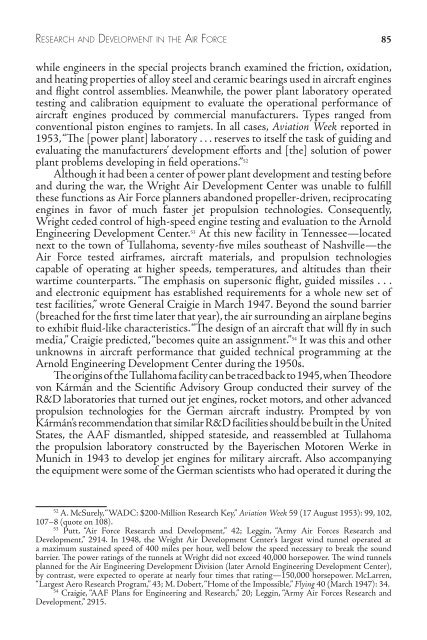To download as a PDF click here - US Army Center Of Military History
To download as a PDF click here - US Army Center Of Military History
To download as a PDF click here - US Army Center Of Military History
You also want an ePaper? Increase the reach of your titles
YUMPU automatically turns print PDFs into web optimized ePapers that Google loves.
ReseaRch a n d developmenT In T h e aIR fo R c e 85<br />
while engineers in the special projects branch examined the friction, oxidation,<br />
and heating properties of alloy steel and ceramic bearings used in aircraft engines<br />
and flight control <strong>as</strong>semblies. Meanwhile, the power plant laboratory operated<br />
testing and calibration equipment to evaluate the operational performance of<br />
aircraft engines produced by commercial manufacturers. Types ranged from<br />
conventional piston engines to ramjets. In all c<strong>as</strong>es, Aviation Week reported in<br />
1953, “The [power plant] laboratory . . . reserves to itself the t<strong>as</strong>k of guiding and<br />
evaluating the manufacturers’ development efforts and [the] solution of power<br />
plant problems developing in field operations.” 52<br />
Although it had been a center of power plant development and testing before<br />
and during the war, the Wright Air Development <strong>Center</strong> w<strong>as</strong> unable to fulfill<br />
these functions <strong>as</strong> Air Force planners abandoned propeller-driven, reciprocating<br />
engines in favor of much f<strong>as</strong>ter jet propulsion technologies. Consequently,<br />
Wright ceded control of high-speed engine testing and evaluation to the Arnold<br />
Engineering Development <strong>Center</strong>. 53 At this new facility in Tennessee—located<br />
next to the town of Tullahoma, seventy-five miles southe<strong>as</strong>t of N<strong>as</strong>hville—the<br />
Air Force tested airframes, aircraft materials, and propulsion technologies<br />
capable of operating at higher speeds, temperatures, and altitudes than their<br />
wartime counterparts. “The emph<strong>as</strong>is on supersonic flight, guided missiles . . .<br />
and electronic equipment h<strong>as</strong> established requirements for a whole new set of<br />
test facilities,” wrote General Craigie in March 1947. Beyond the sound barrier<br />
(breached for the first time later that year), the air surrounding an airplane begins<br />
to exhibit fluid-like characteristics. “The design of an aircraft that will fly in such<br />
media,” Craigie predicted, “becomes quite an <strong>as</strong>signment.” 54 It w<strong>as</strong> this and other<br />
unknowns in aircraft performance that guided technical programming at the<br />
Arnold Engineering Development <strong>Center</strong> during the 1950s.<br />
The origins of the Tullahoma facility can be traced back to 1945, when Theodore<br />
von Kármán and the Scientific Advisory Group conducted their survey of the<br />
R&D laboratories that turned out jet engines, rocket motors, and other advanced<br />
propulsion technologies for the German aircraft industry. Prompted by von<br />
Kármán’s recommendation that similar R&D facilities should be built in the United<br />
States, the AAF dismantled, shipped stateside, and re<strong>as</strong>sembled at Tullahoma<br />
the propulsion laboratory constructed by the Bayerischen Motoren Werke in<br />
Munich in 1943 to develop jet engines for military aircraft. Also accompanying<br />
the equipment were some of the German scientists who had operated it during the<br />
52 A. McSurely, “WADC: $200-Million Research Key,” Aviation Week 59 (17 August 1953): 99, 102,<br />
107–8 (quote on 108).<br />
53 Putt, “Air Force Research and Development,” 42; Leggin, “<strong>Army</strong> Air Forces Research and<br />
Development,” 2914. In 1948, the Wright Air Development <strong>Center</strong>’s largest wind tunnel operated at<br />
a maximum sustained speed of 400 miles per hour, well below the speed necessary to break the sound<br />
barrier. The power ratings of the tunnels at Wright did not exceed 40,000 horsepower. The wind tunnels<br />
planned for the Air Engineering Development Division (later Arnold Engineering Development <strong>Center</strong>),<br />
by contr<strong>as</strong>t, were expected to operate at nearly four times that rating—150,000 horsepower. McLarren,<br />
“Largest Aero Research Program,” 43; M. Dobert, “Home of the Impossible,” Flying 40 (March 1947): 34.<br />
54 Craigie, “AAF Plans for Engineering and Research,” 20; Leggin, “<strong>Army</strong> Air Forces Research and<br />
Development,” 2915.

















